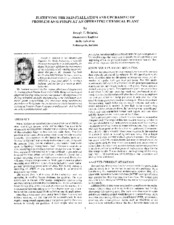| dc.description.abstract | Many facilities do not obtain the expected life out of ANSI and other centrifugal pumps, seals, and bearings that need to be obtained to be competitive in today’s market place. The analysis of this situation leads to two industry wide flaws. The first problem is that many of the pumps were never initially installed correctly. This shortcut on the initial installation leads to a lifetime of high and unnecessary maintenance costs, along with the process leaks, excess emissions, and wasted man-hours spent on fighting a losing battle. And a lifetime is accurate, as some centrifugal pumps have been in service for over 33 years. Once a pump is misinstalled, it is very difficult to get approval to spend the time, effort, and dollars to reinstall a pump that is already operating, albeit at a high maintenance cost. Production will most always take precedence. With typical chemical plants operating over 330 days a year, time is limited for such “unimportant” projects as pump reinstallation. This is why correctly installing an ANSI, or any pump, initially is so critical to trouble free operation. The second flaw is that many of the mechanical seals are operating in stuffing boxes designed for packing. The new technology in current ANSI pumps designed to operate using mechanical seals is worth the conversion cost. End users need to know the benefits of the new seal chambers on the market. It is documented that converting to the four degree taper seal chamber alone has increased seal life three fold on specific applications. Enacting a solution to poor pump installations is a long and tedious mission, but one that can be accomplished. It does require using sound engineering principals to justify the costs needed to remedy the problem. A user might need to test principles that other end users already take for common practice. The twelve steps that were used to justify the reinstallation and upgrading of current problem pumps are reviewed herein. Several of the steps are worked on simultaneously. | en |


